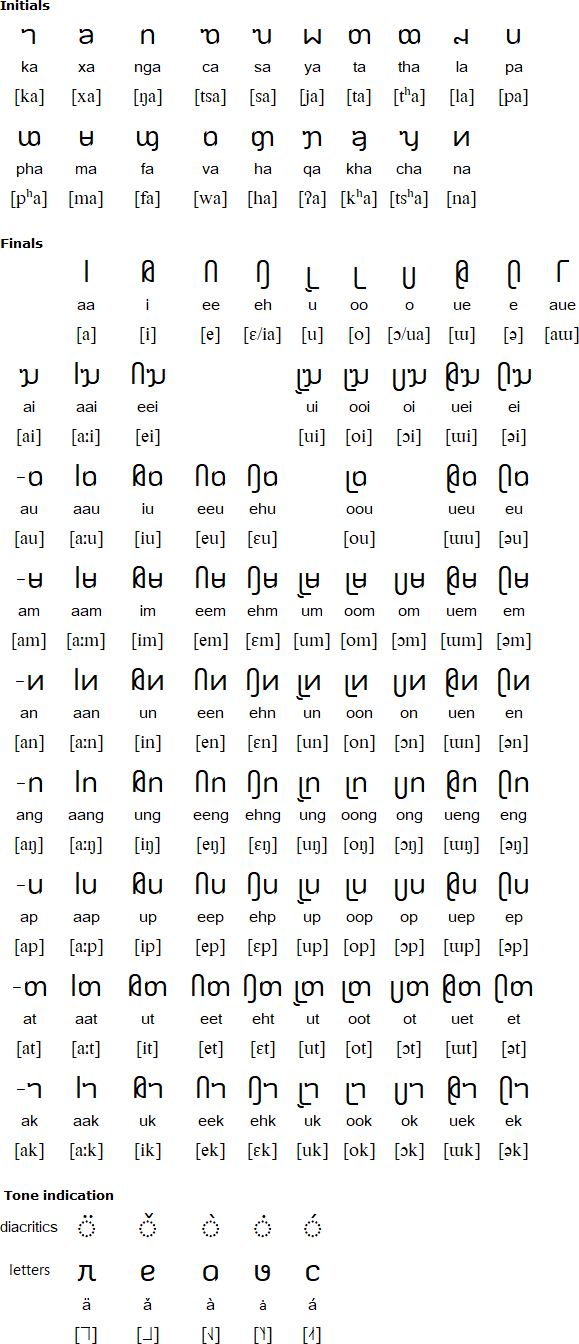The Dehong Dai script is a syllabic alphabet used to write Tai Nuea, a Southwestern Tai language spoken mainly in southwestern China. It is also known as the Tai Le script or Lik Tho Ngok script, and it possibly developed from the Burmese script during the 15th century.
Originally tones were not usually marked in the Dehong Dai script, and there was no distinction between some vowel sounds. In 1956 a revised version of the script with tones indicated by diacritics was officially launched. In 1988 another revision replaced the tone diacritics with the tone letters.

Download an alphabet chart for Dehong Dai (Excel)

This text uses the tone diacritics

This text uses the tone letters
Lauengasom5vana2lai5, kopalai4xoom3xehna6teng2kaa, vaakataap3koon2xeet6maa2see, maat4laa2camaxop3xav4maat5maa2, qaameev2tai2tang2laaai6qotakataakaa3coaithehm6.
Source: http://www.seasite.niu.edu/tai/TaiDehong/, with adjustments by Ian James. Transliteration by Julijan Jovanovic
Information about the Dehong Dai script
https://en.wikipedia.org/wiki/Tai_Le_script
http://www.seasite.niu.edu/tai/TaiDehong
http://www.skyknowledge.com/dehong.htm
https://www.endangeredalphabets.net/alphabets/tai-le/
https://r12a.github.io/scripts/taile/tdd.html
Dehong Dai fonts
http://www.seasite.niu.edu/tai/TaiDehong/
http://www.wazu.jp/gallery/Fonts_TaiLe.html
https://fontzone.net/font-details/microsoft-tai-le
Ahom, Aima, Arleng, Badagu, Badlit, Basahan, Balinese, Balti-A, Balti-B, Batak, Baybayin, Bengali, Bhaiksuki, Bhujimol, Bilang-bilang, Bima, Blackfoot, Brahmi, Buhid, Burmese, Carrier, Chakma, Cham, Cree, Dehong Dai, Devanagari, Dham Lipi, Dhankari / Sirmauri, Ditema, Dives Akuru, Dogra, Ethiopic, Evēla Akuru, Fox, Fraser, Gond, Goykanadi, Grantha, Gujarati, Gunjala Gondi, Gupta, Gurmukhi, Halbi Lipi, Hanifi, Hanuno'o, Hočąk, Ibalnan, Incung, Inuktitut, Jaunsari Takri, Javanese, Kaithi, Kadamba, Kamarupi, Kannada, Kawi, Kharosthi, Khema, Khe Prih, Khmer, Khojki, Khudabadi, Kirat Rai, Kōchi, Kodava Lipi, Komering, Kulitan, Kurukh Banna, Lampung, Lanna, Lao, Lepcha, Limbu, Lontara/Makasar, Lota Ende, Magar Akkha, Mahajani, Malayalam, Meitei (Modern), Manpuri (Old), Marchen, Meetei Yelhou Mayek, Meroïtic, Masarm Gondi, Modi, Mon, Mongolian Horizontal Square Script, Multani, Nandinagari, Newa, New Tai Lue, Ojibwe, Odia, Ogan, Pahawh Hmong, Pallava, Phags-pa, Purva Licchavi, Qiang / Rma, Ranjana, Rejang (Kaganga), Sasak, Savara, Satera Jontal, Shan, Sharda, Sheek Bakrii Saphaloo, Siddham, Sinhala, Sorang Sompeng, Sourashtra, Soyombo, Sukhothai, Sundanese, Syloti Nagri, Tagbanwa, Tai Noi, Takri, Tamil, Tanchangya (Ka-Pat), Tani, Thaana, Telugu, Thai, Tibetan, Tigalari, Tikamuli, Tocharian, Tolong Siki, Vatteluttu, Warang Citi
Page last modified: 17.03.25
[top]
You can support this site by Buying Me A Coffee, and if you like what you see on this page, you can use the buttons below to share it with people you know.

If you like this site and find it useful, you can support it by making a donation via PayPal or Patreon, or by contributing in other ways. Omniglot is how I make my living.
Note: all links on this site to Amazon.com, Amazon.co.uk
and Amazon.fr
are affiliate links. This means I earn a commission if you click on any of them and buy something. So by clicking on these links you can help to support this site.
[top]